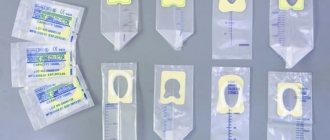Any mother closely monitors the health of her child. Every day since birth, she diligently performs hygiene procedures and carefully examines every fold on her baby’s body. Many women, upon discovering discharge in newborn girls, begin to panic. What this phenomenon means and in what cases it is necessary to take action, we will find out in this article.
Hormonal crisis of newborns
During development inside the womb, the child, together with the mother, goes through all stages of hormonal changes and receives sex hormones in considerable concentration.
Before birth, the level of these substances is especially high, and after birth in infants it gradually returns to normal. This process is called a sexual or hormonal crisis. Its manifestations can be seen in both boys and girls in the form of acne, swelling of the mammary glands, and in some cases the release of a substance similar to colostrum is noticeable from them.
Often in infants in the first month there is swelling of the genital organs, accompanied by a certain secretion. This is also a consequence of the release of the sex hormones estrogen. It can be bloody, liquid white, yellow or green, and mucous in nature. In most cases this is the norm, but there are exceptions.
Signs of a hormonal crisis can appear from 1–2 days to several months, and its peak occurs 6–7 days after birth. Basically, complete cleansing of excess hormones is completed in the fifth week.
When is it necessary to visit a pediatric gynecologist?
What should cause concern is that vaginal secretions continue to be released abundantly several months after the baby is born. Also, a reason to contact a specialist is that the discharge has a purulent odor and looks the same. In addition, it is worth paying attention to the child’s behavior. If a newborn girl constantly cries while urinating, this means that she is experiencing severe discomfort or pain, which, of course, cannot be called the norm.
You should visit a doctor as soon as possible even if the discharge is not bloody, but is accompanied by quite serious bleeding. In this case, we are talking about a dangerous situation where one cannot hesitate. In addition, there is a big difference between white-pink vaginal discharge and the color of urine. If there are red spots in it, then this is a cause for serious concern. In this case, the symptom indicates problems with internal organs. The same applies to those situations when, in addition to secretion, the baby’s nose begins to bleed.
For any anatomical abnormalities in the development of the genital organs, you should consult a pediatric gynecologist. Perhaps the deformation is caused by nutritional deficiencies or more serious pathologies.
Bloody vaginal discharge in infants
According to statistics, discharge in infants occurs in 9% of cases. This phenomenon is called neonatal metrorrhagia. The child’s genital organs: the surface of the uterus, its cervix and the vaginal mucosa are in a similar condition to the organs of a woman of reproductive age before menstruation.
The hormone estrogen received from the mother stops acting, as a result of which the mucous layer of the uterus is rejected. Blood discharge in an infant girl can be pink, scarlet, brown, or beige. The secretion appears a few days after birth and disappears after 2-3 days.
There is no reason to worry in this situation. The main thing is to maintain the hygiene of the newborn and ensure that such processes do not drag on for a long time.
Mucous and white discharge in newborn girls
The presence of white discharge in infant girls is associated with the following reasons:
- Remains of original lubricant. Indicated in the form of a mucous coating, reminiscent of sticky leucorrhoea, in the vagina and on the folds of the labia. Pediatricians do not recommend washing them out with special means, but recommend waiting until the substance disappears naturally. With its help, the baby's sensitive skin adapts to the new external environment.
- Mucus can also be produced by the glands of the vagina. The reason for these discharges is the same as for bloody ones - hormones, only in this case the hormones responsible for milk production work: prolactin and progesterone. This kind of secretion in infants usually disappears by the end of the first month.
- A similar symptom may occur due to the reaction of the newborn’s body to hormonal changes that can provoke the development of vulvovaginitis. Discharge is indicated in small quantities, and they are white, yellow, green, and sometimes transparent. Vaginitis is often accompanied by redness and swelling of the baby’s external genitalia. The symptoms go away after a few days and do not cause discomfort to the baby.
Pathological discharge in girls under one year old
The appearance of vaginal discharge in girls under one year of age in 90% of cases is a characteristic of the norm, since this period is characterized by regular hormonal fluctuations. But sometimes this sign indicates pathology.
You should be wary if:
- secretion does not disappear two months after birth;
- the duration of discharge is more than 2–3 days;
- mucus has an unpleasant odor and purulent nature;
- the baby cries when urinating, because it is accompanied by discomfort;
- there is excessive discharge, bleeding;
- there is an inflammatory process in the genital organs;
- an atypical color of urine and blood admixtures were noticed;
- A violation of the anatomical development of the genital organs was diagnosed.
These phenomena can occur due to physiological problems in the child, but most often they occur due to improper care of the genitals.
If the child is 3 months or older
If parents notice white discharge in a newborn girl, this is normal, but in the third month of life this may be the first sign of an inflammatory process in the baby’s body. Therefore, you should not postpone your visit to the pediatric gynecologist. Most often at this age, unpleasant symptoms appear against the background of:
- Bacterial vulvovaginitis. However, in this case, the girl’s discharge will not be white, but yellow. Redness may be noticeable in the groin area.
- Vulvovaginitis caused by enterobiasis. In this case, we are talking about worms that transferred pathogenic microorganisms from the child’s intestines to the vagina.
- Entry of a foreign body into the vagina. These could be pieces of toilet paper, threads and much more. This may well cause damage to the child's vagina and lead to serious inflammation.
- Exudative diathesis. This pathology is classified as chronic. This condition can lead to vulvar hyperemia. This causes dryness of the vaginal mucous membranes.
- Candidiasis. Such manifestations can also occur against the background of herpes. It may well provoke the appearance of white discharge in newborn girls and older babies.
- Trichomonas. A newborn baby can become infected through the birth canal, and an older girl can become infected through household means. In this case, the discharge will be more foamy.
It is also worth considering one of the most common reasons for the appearance of white mucous discharge in a newborn girl.
Hygiene of a newborn girl
A girl’s discharge may appear at 1, 2, 3, or 4 months. All this is the result of changes in hormonal levels, which are especially active in the first year of life. The main rule during this period is to maintain hygiene for the infant, which is especially important in the first month of life.
- When washing your child, use only boiled water at 36 °C. Some experts advise using chamomile decoction, but remember, it can dry out the mucous membranes and also cause an allergic reaction. Therefore, it is better to choose special cosmetics intended for newborns for these purposes. Sometimes they can be alternated with a weak decoction of the series.
- When washing, the perineum is washed first, and only then the anus, i.e. the direction of movement is from front to back. Otherwise, feces or opportunistic bacteria from the anus can enter the genitals and provoke the development of an infectious or inflammatory process. In the first month, wash your baby as often as possible.
- Do not try to remove the white residue mentioned above. This lubricant will go away on its own.
- Be sure to cut the nails on your hands so as not to damage the child’s mucous membrane during water procedures.
- From time to time, spread the baby's labia to prevent them from merging.
- When using creams or diaper powders, make sure that the products do not get into the perineum.
- Periodically give your baby air baths. The skin should rest from diapers and diapers.
- Monitor odors and discharge patterns, if any.
How to care for your baby's vagina
Proper intimate hygiene for an infant is an important point for the further development of organs and women's health. Caring for the baby should take place in the following sequence:
- Wash your hands with soap to avoid infection in your baby's vagina during the procedure.
- Wash your baby every time you change her diaper (about every 3-4 hours during the day). Hygiene procedures are required after waking up in the morning and before going to bed in the evening.
- Do not wash the girl in the bath; the water should be running and the pressure should not be strong.
- You need to wash the baby towards the anus. This is necessary to prevent feces from getting into the vagina and causing inflammation.
- Carry out hygiene of the anus and vagina separately. After washing the anus, wash your hands with soap and then wash the girl. This will prevent E. coli from entering the genitals, which leads to inflammation of the genitourinary tract.
- Use only plain water or water with chamomile infusion added. Use baby soap or gel to wash after bowel movements.
- Do not use a washcloth so as not to injure the baby’s delicate mucous membranes.
- Remove any remaining powder and cream from the labia with a cotton swab and sterilized oil in the morning and evening.
If in the first weeks of your baby's life you notice white or bloody discharge from the vagina, do not be alarmed, but keep an eye on it. This is a hormonal or sexual crisis that will pass in a few days.
Comfortable position
Feedback from women and expert opinion
Maria, 26 years old: “On the 7th day after the birth of her daughter, she discovered bloody-pinkish discharge. I was very scared, although the child did not cry and behaved calmly. It was Saturday and while we waited until Monday to see a doctor, the blood disappeared. What should we do?" Maria Stepanovna, pediatrician: “In newborns, in the first weeks of life, a sexual crisis occurs, associated with the liberation of the baby’s body from maternal hormones accumulated during the intrauterine period. In girls, it manifests itself as bloody vaginal discharge. They come in pink, brown and ichor-shaped. The phenomenon disappears after 2–3 days, but sometimes appears until the second month. This is a natural process, there is no reason to worry.” Angelina, 35 years old: “My daughter is 4 days old. Even when I started looking at her on the first day, I saw a white coating on the labia. I tried to remove it with wet wipes but nothing worked. Maybe it's thrush? Maria Stepanovna, pediatrician: “In the first days of life, remnants of vernix lubrication can be observed on the body of a newborn. They are especially noticeable on the baby's head and in the folds on the body. In girls, they accumulate in the labia and perineum. There is no need to delete them. The plaque will go away on its own in a few days, but if its presence has increased and the baby begins to act up, only then is there reason to suspect some kind of disorder and consult a doctor. In 95%, we are talking about a natural physiological process.”









